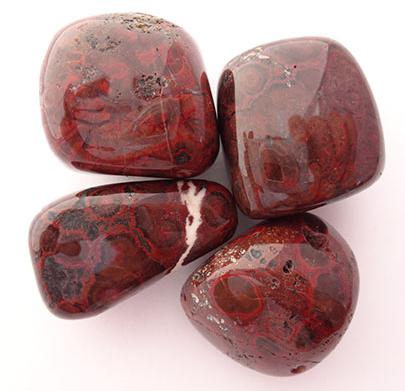Cinnabar is a mineral that has long been the basis of saturated red paint. It was made by the Etruscans, and the ancient Egyptians, and the Phoenicians. At the same time, such paint was used in painting icons in Russia. The mineral on fresh cleavage resembles bright spots of blood. From Arabic, “cinnabar” is translated as “dragon blood”. The second name of the stone is cinnabarite.
Cinnabar is a mineral that contains 86.2% of mercury. It crystallizes in syngony, mainly forming small thick-plate or rhombohedral crystals, powdery or granular crystalline masses. The stone is also characterized by twins of germination and perfect cleavage in the first direction. In thin fragments, the mineral is transparent, has an interesting "diamond" brilliance. The stone melts easily, and when heated to 200˚C it completely evaporates, forming vapor of sulfur dioxide and mercury.
Origin
These minerals and stones are the most common mercury minerals. They occur in near-surface hydrothermal deposits along with calcite, quartz, antimonite, barite, galena, pyrite, marcasite, sometimes with native gold and native mercury. Cinnabar is often deposited in veins in jasperoid strongly metamorphosed rocks associated with hot alkaline springs and recently stopped volcanic activity.
Of independent industrial interest are residual rather large eluvial-slope placers, alluvial and spoon placers of near demolition, gold placers, from which cinnabar is simultaneously extracted. Residual placers of the mineral are most common in places where chemical weathering crusts appear. Small but very rich accumulations of the mineral are confined to deluvial and eluvial deposits in karst cavities and funnels.

In high and moderate latitudes, cinnabar can also be found. This is due to the collapse on the rivers and slopes in the ore field. The eluvial-slope deposits of the mineral are in the form of reservoir deposits and contain cinnabar together with quartz (native mercury is also found). But in alluvial and spoon placers, the mineral accumulates in the form of grains and rounded pebbles, which are composed of massive dense differences. Its main mass is on the raft. The length of these placers is 1-2 km, and the thickness of the formation is up to 3 m. They are mainly associated with root sources that go to the bottom of the valleys, in addition, they are deposits of a nesting or stream structure. Cinnabar placers are found in North America, in the North-East of Russia. Pliocene-Quaternary mineral placer age; at the same time, alluvial buried cinnabar placers among coastal basins were revealed in the North-East of our country.
Place of Birth
The largest deposit in the world is located in Spain; until recently, it accounted for about 80% of all mercury production in the world. Also mined in Ukraine, Yugoslavia, Italy, USA. Of the deposits in Central Asia, the largest is in Kyrgyzstan (Khaidarkan and Chauvai), as well as in Tajikistan (Adrasman). In our country, there is also a large deposit in Chukotka.
Magical properties
Professionals claim that cinnabar is a mineral that understands and feels all the problems of its owner, but does not calm, but teaches a difficult period to experience easier - to laugh at the situation and yourself. The stone shows the owner how to behave in order to avoid trouble in the future. In general, cinnabar, the color of which is associated with blood for many, can change the human character and teach you how to live, not survive, learning life lessons and having fun.
Astrologers advise wearing products with this mineral to all zodiac signs with the exception of Scorpio. Best of all, he serves Taurus. Although if you constantly carry minerals and stones with you, then the state of human health can be shaken. Due to this, experts advise to wear a product with such a nugget only in difficult life situations. At the same time, do this until the moment the attitude to the precedent changes, and the person begins to relate trouble to humor.
Cinnabar was especially prevalent during the heyday of alchemy in Europe. Then mercury was a symbol of the search for immensity. It was an indispensable component of the research of every self-respecting alchemist. For many, the violet hue of mercury vapor is still associated with a riddle.
Needless to say, alchemists did not often live to be thirty years old, and most of them, according to contemporaries, showed signs of mercury poisoning.
Healing properties
Since cinnabar is a mercury sulfide, this mineral cannot be used for treatment. Its ingestion can lead to poisoning or death of a person. In the East, in ancient times, stone was used to treat leprosy, although its effectiveness is questionable. In small doses, cinnabar was used in Europe, the color of which affects many today, for the treatment of syphilis, but often this led to death or severe poisoning of the patient.
Amulets and Talismans
This stone is the talisman of financiers, businessmen, people who tend to dramatize situations, as well as everyone who repeats a mistake several times. It can be used with caution and occasionally.
Interesting
Red cinnabar in the Roman Empire was mined to produce red natural pigment and mercury. And today, some of the Roman mines are being developed. Pliny the Elder in his writings mentions that in Spain Ancient Rome bought about 4.5 tons of mercury every year.
Another ancient mine is Khaidarkan in Kyrgyzstan, where various traces of ancient works have also been preserved: metal wedges, large workings, clay retorts for cinnabar firing, lamps, huge dumps of cinder resulting from this. Archaeological excavations show that mercury was mined in Kyrgyzstan for many centuries, and only in the 13-14 centuries, after the successors of Genghis Khan here destroyed all the artisan-trading centers, ore mining was stopped. In the mid-twentieth century, this Khaidarkan field actively resumed its work. In ancient times, the mineral was not mined as a source of mercury, but as an expensive and irreplaceable mineral pigment.